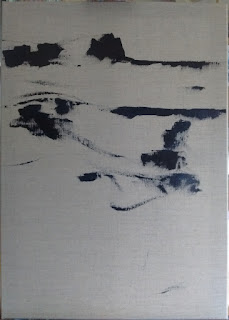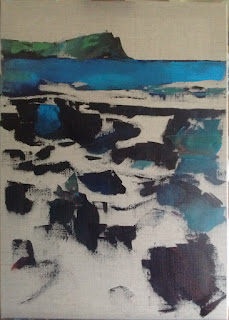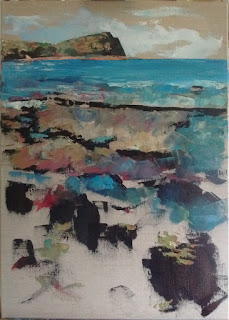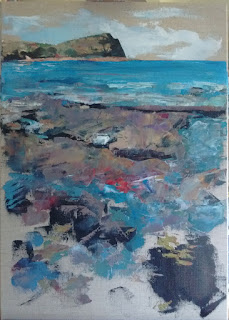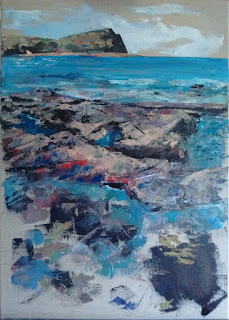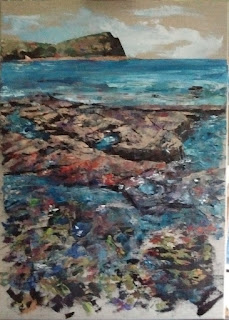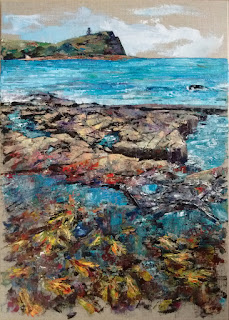 |
| Purbeck Eddies, oil on canvas, 40 x 50 cm |
Saturday, 27 May 2017
Purbeck Eddies
Monday, 22 May 2017
Recorders and Lute: Palisander and Toby Carr (triptych)
It's not over until...
Open Studios West Berkshire and Nort Hampshire has technically finished, but there are a few satellite exhibitions lingering here and there and, of course, there are several studios that are full time affairs and which will often open by appointment.
So yes, you can still visit me. Just get in touch...
[Contact page] [Open Studios Directory entry, includes full contact details]
The outstanding exhibitions that I know about (because I'm involved in them) are:
Art in Music at the Corn Exchange in Newbury - on until 24 May, during performances only;
Cover to Cover (exchange sketchbooks) at the West Berkshire Museum in Newbury - on until 30 May;
North Hampshire Art at the Willis Museum in Basingstoke - on until 3 June.
So yes, you can still visit me. Just get in touch...
[Contact page] [Open Studios Directory entry, includes full contact details]
The outstanding exhibitions that I know about (because I'm involved in them) are:
Art in Music at the Corn Exchange in Newbury - on until 24 May, during performances only;
Cover to Cover (exchange sketchbooks) at the West Berkshire Museum in Newbury - on until 30 May;
North Hampshire Art at the Willis Museum in Basingstoke - on until 3 June.
Sunday, 21 May 2017
The road to Kimmeridge: some in-progress shots
Sometimes I think I might forget how I did something (and the best somethings are often the result of a happy accident) or, more often, I worry that the next bold stroke of the knife will wipe out the best bit of a painting. So I've got into the habit of taking quick photographs of the current work-in-progress in the studio when my hands are clean enough to operate a camera (in the field is different; there's more time pressure and, usually, fewer distractions).
This post contains a sequence of such photographs, with notes, for the painting of Kimmeridge, which was painted on a clear-gessoed linen canvas with the six tube version of my standard palette: burnt umber, ultramarine, phthalo blue, lemon yellow, rose madder quiacridone. Most of the knife work was done with a Winsor and Newton no.27, with a smaller knife (Langnickel LP-1) used later on. I also used a silicone colour shaper for a few details and my signature.
I'm working from a photograph that I took in 2014. I hadn't seen the possibilities of the shot until now (except maybe in the instant that I took it). I remember the day. It was hot, very hot for England, the heat of the sun bouncing off the rocks. My husband and children were in and out of the sea but I felt unable, uncertain of my physicality, uncomfortable in the heat and unsure of my balance - and besides, I wanted to sketch. I made a very bad, overworked and tiny watercolour of the distant Clavell Tower. And I took lots of photographs.
This was one of them.
Nearly three years later, I picked it out for the studio treatment. There was a lot of fiddly detail that would challenge the knife; of course, it wouldn't all go in, but if there was any chance of making the Clavell Tower recognisable in any way, I had to use a fairly large canvas. And I was trying not to think about the seaweed, but its colours anchored the image and justified the long format, so I would need to make them work... somehow.
This post contains a sequence of such photographs, with notes, for the painting of Kimmeridge, which was painted on a clear-gessoed linen canvas with the six tube version of my standard palette: burnt umber, ultramarine, phthalo blue, lemon yellow, rose madder quiacridone. Most of the knife work was done with a Winsor and Newton no.27, with a smaller knife (Langnickel LP-1) used later on. I also used a silicone colour shaper for a few details and my signature.
I'm working from a photograph that I took in 2014. I hadn't seen the possibilities of the shot until now (except maybe in the instant that I took it). I remember the day. It was hot, very hot for England, the heat of the sun bouncing off the rocks. My husband and children were in and out of the sea but I felt unable, uncertain of my physicality, uncomfortable in the heat and unsure of my balance - and besides, I wanted to sketch. I made a very bad, overworked and tiny watercolour of the distant Clavell Tower. And I took lots of photographs.
This was one of them.
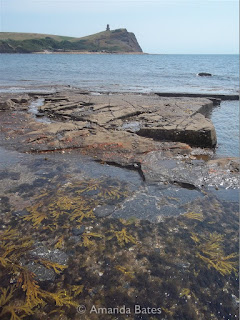 |
| You don't get to see my source photographs very often. |
Nearly three years later, I picked it out for the studio treatment. There was a lot of fiddly detail that would challenge the knife; of course, it wouldn't all go in, but if there was any chance of making the Clavell Tower recognisable in any way, I had to use a fairly large canvas. And I was trying not to think about the seaweed, but its colours anchored the image and justified the long format, so I would need to make them work... somehow.
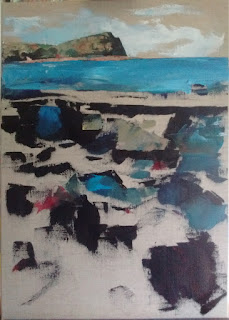 |
| Oh, thank goodness for that. There's the sky. And some pink bits. |
Saturday, 20 May 2017
Kimmeridge
Kimmeridge Bay in Purbeck, Dorset is all about the rocks. It lies on the Jurrassic Coast and is a favoured destination for fossil-hunters as well as rock-pool afficianados and snorkellers. It has clear, calm water and a folly on the headland - Clavell Tower, which in 2006-8 was moved away from the crumbling cliff.
So, of course, my painting is all about the rocks. The flat rocks in the centre dominate the image. I spent most of my time on their colours, curves and cracks, their attendant pools and the wet reflections of the summer sun, but it was the seaweed that worried me most. It was a curious colour - a bright mix of yellow, green, red and orange - and it was underwater, right in the foreground. How could I indicate that with my knife, a blunt painting instrument if ever there was one? In the end, it was all a matter of observation and approximation, as is often the case, and allowing the viewer's visual cortex to fill in the gaps.
Kimmeridge
Oil on linen canvas, 50 x 70 cm
£400
Labels:
70 x 50 cm,
Cliffs,
Coastal,
Dorset,
For Sale,
Oil painting,
Rocks,
sea,
Seaweed,
Water
Monday, 15 May 2017
Arctic Corsair - painting from a sketch and believing in the sketch
The best thing about painting from a sketch is that you've already made most of the decisions about what to leave out.
The worst thing about painting from a sketch is that you've already made most of the decisions about what to leave out.
When I made these two sketches, I wasn't really thinking about whether or not I would use them for a painting, I was just enjoying sketching. Which is what I usually do. Still, with detail in the line drawing, focussing on the boat, and colour in the drawing of the buildings alongside it, I thought I would be able to do a passable job of recreating the scene.
The following is a description of how I painted this. I used a painting knife with oils on a clear-gesssoed linen canvas.
The worst thing about painting from a sketch is that you've already made most of the decisions about what to leave out.
When I made these two sketches, I wasn't really thinking about whether or not I would use them for a painting, I was just enjoying sketching. Which is what I usually do. Still, with detail in the line drawing, focussing on the boat, and colour in the drawing of the buildings alongside it, I thought I would be able to do a passable job of recreating the scene.
The following is a description of how I painted this. I used a painting knife with oils on a clear-gesssoed linen canvas.
Arctic Corsair
The Arctic Corsair is the last of Kingston-Upon-Hull's side-winder trawlers, efectively the last remnant of the city's fishing fleet. She currently lies on the mud in the river Hull by the museum quarter and is a museum ship herself. She has been there since 1999 (after the time I lived in Hull) but there is talk of moving her to a dry dock in the near future.
The painting is based on a couple of sketches that I made in January 2016. There is a little artistic licence in a few places - the riverfront warehouse on the right, for example, is a complete fabrication! The jagged red brick edifice in the background, in front of the cream-coloured Shotwell building, on the other hand, was there and was in approximately that shape when I drew the Corsair and her surroundings. It was partially demolished and looked rather like a post-industrial castle.
The painting is based on a couple of sketches that I made in January 2016. There is a little artistic licence in a few places - the riverfront warehouse on the right, for example, is a complete fabrication! The jagged red brick edifice in the background, in front of the cream-coloured Shotwell building, on the other hand, was there and was in approximately that shape when I drew the Corsair and her surroundings. It was partially demolished and looked rather like a post-industrial castle.
Arctic Corsair
Oil on canvas, 55 x 46 cm
£200
Sunday, 14 May 2017
The Woolhampton Green People
Green Man; Green Lady
Acrylic ink on A3 Bockingford rough watercolor paper
Acrylic ink on A3 Bockingford rough watercolor paper
Nearly 18 months ago, I posted some pencil sketches made of two carved faces from a local church, St Peter's in Upper Woolhampton. These pictures are based on those sketches. The faces are Victorian (the church was rebuilt in 1857) and, with their surroundings of leaves, the gentleman's leafy moustache and the vegetation emerging from the lady's mouth, are in the green man tradition. I fancy that they might represent the local landowner and his wife.
Friday, 12 May 2017
Restoration Project
Every now and then I decide to alter my palette as a one-off, to use colours I don't use often. It kind of shakes things up a bit as well as usefully delpeting those odd colours that I'm never really going to use often... or maybe make me reconsider the usefulness of some of those colours.
I chose this subject - found in a barn while walking near Chievely in Berkshire - because of its strong shapes. My collection of odd colours inludes a couple of vibrant oranges and orangey earth tones; here, I used Chrome Orange (hue), Pyrrole Orange and Indian Red. I thought they would work well for the different shades of rust. Continuing the odd colours theme, I picked out Phthalo Blue (red shade - I normally use the green shade) and Yellow Green. White is difficult to do without, so I included it, and there was some Rose Madder Quinacridone left on my palette, too, so that ended up in the picture as well.
I chose this subject - found in a barn while walking near Chievely in Berkshire - because of its strong shapes. My collection of odd colours inludes a couple of vibrant oranges and orangey earth tones; here, I used Chrome Orange (hue), Pyrrole Orange and Indian Red. I thought they would work well for the different shades of rust. Continuing the odd colours theme, I picked out Phthalo Blue (red shade - I normally use the green shade) and Yellow Green. White is difficult to do without, so I included it, and there was some Rose Madder Quinacridone left on my palette, too, so that ended up in the picture as well.
Restoration Project
Oil on canvas, 40 x 50 cm
£120
Entrance (Chysauster)
I find prehistoric sites entrancing: open to the elements, often in (relatively) remote locations, they are refreshing in their wild freedom yet retain a palpable sense of history. I also rather like painting stones.
This is the entranceway to one of Chysauster's "courtyard" huts. Chysauster, in west Cornwall, is a remarkably well preserved iron age village managed by English Heritage.
My painting was made last week while my studio was open as part of Open Studios West Berkshire and North Hampshire. There's still just over a week of Open Studios left; you'll find my dates and details here.
This is the entranceway to one of Chysauster's "courtyard" huts. Chysauster, in west Cornwall, is a remarkably well preserved iron age village managed by English Heritage.
My painting was made last week while my studio was open as part of Open Studios West Berkshire and North Hampshire. There's still just over a week of Open Studios left; you'll find my dates and details here.
Entrance (Chysauster)
Oil on canvas, 55 x 46 cm
£190
Bluebell Stump (Wolverton Blue 2) - SOLD
Wednesday's short painting session in Wolverton Wood gave me enough material (on the canvas and in my head) to refine the image in the studio yesterday.
£120 SOLD
Bluebell Stump (Wolverton Blue 2)
Oil on natural linen canvas, 30 x 40 cm
Wednesday, 10 May 2017
Bluebelling
 |
| ... in progress ... |
 |
| ... and mostly finished. |
Sunday, 7 May 2017
Step Over (Chysauster)
 |
| Oil on canvas, 40 x 40 cm (03/05/17) |
It's painted from my photograph of the steps over a Cornish Hedge on the approach to Chysauster, an iron age village in Cornwall.
Subscribe to:
Posts (Atom)


